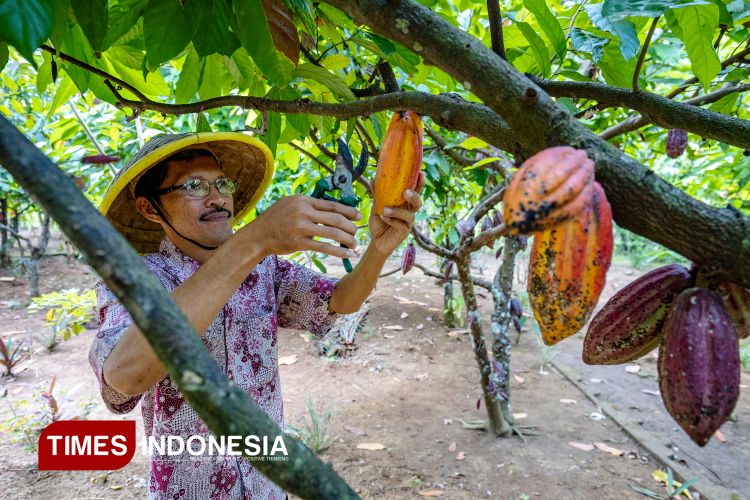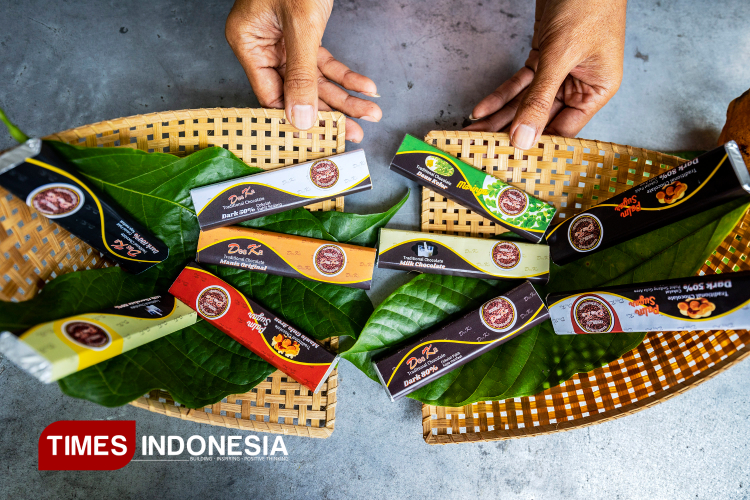Harvesting Happiness: Inside the World of Taman Kakao Coklat

TIMESINDONESIA, YOGYAKARTA – When his father passed away in 2014, Johan Salbiantoro, then 50 years old, inherited the family cocoa plantation in Kulon Progo, Yogyakarta. Rather than simply continuing traditional farming, Johan envisioned something more impactful. He decided to transform the plantation into Taman Kakao Coklat.
Taman Kakao Coklat means “Chocolate Cocoa Park” in English. It's a destination where visitors could not only enjoy cocoa but also learn about its cultivation and processing. Today, this site in Dukuh Slanden, Banjaroyo Village, Kalibawang has grown into an internationally recognized educational tourism attraction.
Advertisement
The journey began as early as 2013, when Johan joined the Ngudi Rejeki Farmers Group as one of its youngest members. The 2010 eruption of Mount Merapi had devastated many cocoa farms, but rehabilitation programs from the local government and Ministry of Agriculture brought fresh seedlings and new hope to farmers.
Johan took the opportunity to reorganize the plantation layout, build accessible concrete pathways, and introduce facilities for guests. With help from students doing internships, he promoted the plantation through social media, gradually attracting more domestic and foreign visitors.
Mastering the Art of Chocolate
In 2018, Johan took a bold step into chocolate production. A South Korean visitor who stayed at his home for three months taught him the art of roasting cocoa beans traditionally. This sparked Johan’s passion to create his own chocolate products rather than selling all his beans to middlemen.
 Johan's sister rying the cocoa beanss before going to the next process.(Photo: Eko Susanto/TIMES Indonesia)
Johan's sister rying the cocoa beanss before going to the next process.(Photo: Eko Susanto/TIMES Indonesia)
Later, assistance from the local agriculture office helped him acquire a modern cocoa processing machine, significantly improving efficiency and product variety.
Visitors to Taman Kakao Coklat can now enjoy a complete cocoa experience from bean to bar. They begin with a guided tour through lush cocoa groves, learning how the plants are grown, maintained, and harvested.
The tour continues with hands-on lessons in processing cocoa beans, including roasting, grinding, and molding chocolate. Finally, guests can sample an array of rich chocolate and beverage creations made on-site.
Chocolate Delights and Agricultural Challenges
The plantation offers an impressive selection of 11 chocolate flavors, ranging from classic varieties to unique blends. Popular choices include original, milk, palm sugar, ginger, honey, cashew, almond, and sweet chocolate.
 Chocolate bars, one of the product of Taman Kakao Coklat. (Photo: Eko Susanto/TIMES Indonesia)
Chocolate bars, one of the product of Taman Kakao Coklat. (Photo: Eko Susanto/TIMES Indonesia)
Beverages are equally diverse, with options like taro chocolate, avocado chocolate, palm sugar chocolate, and cocoa-coffee blends. Prices are kept affordable, starting from Rp 10,000 to Rp 20,000 per item, making them attractive souvenirs for visitors.
From his 300 cocoa trees, Johan typically harvests around seven kilograms per week. The harvest season peaks between September and October, yielding up to 20 kilograms weekly.
Higher-grade beans are either processed into premium chocolate products or sold to other chocolate makers, while lower-grade beans go to local distributors. Johan earns far more by processing his own beans, but the farm still faces challenges such as pests like frokeltis and fungal diseases like phytophthora.
To address these agricultural threats, Johan collaborates with agricultural students on research and pest control strategies. He believes that maintaining the plantation is about more than securing profits—it is about preserving the cultural and agricultural heritage of his village.
Educational programs at Taman Kakao Coklat reflect this mission, offering visitors not only a taste of chocolate but also knowledge about sustainable cocoa farming. These programs have helped raise awareness of cocoa’s importance and inspire young farmers to take an interest in agriculture.
Sweet Tourism for All
Holiday seasons are the busiest times, with domestic tourists visiting on weekends and international travelers arriving mostly in summer. Strolling around the plantation is free of charge, while the guided educational package costs Rp 100,000 per person.
For groups, the price can be reduced to as low as Rp 20,000 per person, making it accessible to schools, communities, and tour groups. Johan’s commitment ensures that Taman Kakao Coklat remains a welcoming, educational, and delicious destination for all.
For Johan, the transformation of his father’s land is both a business achievement and a heartfelt contribution to his community. His work has put Kulon Progo’s cocoa on the map, showing that rural tourism can have global appeal when rooted in quality, culture, and education.
As Taman Kakao Coklat continues to grow, it serves as a model of how local heritage can be preserved while fostering economic opportunities. With each visitor who leaves carrying sweet memories—and sometimes a bag of handmade chocolate—Johan’s dream of sharing the taste of Kulon Progo with the world moves closer to reality. (*)
**) Ikuti berita terbaru TIMES Indonesia di Google News klik link ini dan jangan lupa di follow.
| Editor | : Khodijah Siti |
| Publisher | : Lucky Setyo Hendrawan |

